Evaluation of Sc Concentrations in Ni-Co Laterites Using Al as a Geochemical Proxy
Abstract
:1. Introduction
2. Regional Geology
3. Methodology
3.1. Sampling Strategy
3.2. Analytical Strategy
4. Lithofacies and Mineral Assemblages
5. Whole-Rock Geochemical Correlations at the Deposit Scale
6. Mineral Chemistry
7. Sequential Extractions
8. Discussion and Implications for the Evaluation of Sc in Ni-Co Laterites
8.1. Co-Evolution of Al and Sc Concentration and Speciation through Weathering
8.2. Implications for the Assessment of Sc in Ni-Laterites
9. Conclusions
Supplementary Materials
Author Contributions
Funding
Data Availability Statement
Acknowledgments
Conflicts of Interest
References
- Royset, J.; Ryum, N. Scandium in aluminium alloys. Int. Mater. Rev. 2005, 50, 19–44. [Google Scholar] [CrossRef]
- Toropova, L.S.; Eskin, D.G.; Kharakterova, M.L.; Dobatkina, T.V. Advanced Aluminium Alloys Containing Scandium. In Structure and Properties; Gordon and Breach Science Publishers: Amsterdam, The Netherlands, 1998; p. 175. [Google Scholar]
- US Geological Survey. Scandium. In Mineral Commodity Summaries; U.S. Geological Survey: Reston, VA, USA, 2022; pp. 146–147. [Google Scholar]
- Aiglsperger, T.; Proenza, J.A.; Lewis, J.F.; Labrador Svojtka, M.; Rojas-Puron, A.; Longo, F.; Durisova, J. Critical metals (REE, Sc, PGE) in Ni laterites from Cuba and the Dominican Republic. Ore Geol. Rev. 2016, 73, 127–147. [Google Scholar] [CrossRef]
- Audet, M. Le massif du Koniambo, Nouvelle-Calédonie. Formation et Obduction d’un Complexe Ophiolitique du Type SSZ. Enrichissement en Nickel, Cobalt et Scandium Dans Les Profils Résiduels. Ph.D. Thesis, Université de la Nouvelle Calédonie, Noumea, France, Université du Quebec à Montréal, Montréal, QC, Canada, 2008; 326p. [Google Scholar]
- Bailly, L.; Ambrosi, J.P.; Barbarand, J.; Beauvais, A.; Cluzel, D.; Lerouge, C.; Prognon, C.; Quesnel, F.; Ramanaïdou, E.; Ricordel-Prognon, C.; et al. Nickal—Typologie des Latérites de Nouvelle-Calédonie. Gisements de Nickel Latéritique, Volume II. CNRT « Nickel & Son Environnement». 2014. Available online: https://horizon.documentation.ird.fr/exl-doc/pleins_textes/divers19-02/010075036.pdf (accessed on 20 March 2022).
- Chassé, M.; Griffin, W.L.; O’Reilly, S.Y.; Calas, G. Scandium speciation in a world-class lateritic deposit. Geochem. Perspect. Lett. 2017, 3, 105–114. [Google Scholar] [CrossRef] [Green Version]
- Chassé, M.; Griffin, W.L.; O’Reilly, S.Y.; Calas, G. Australian laterites reveal mechanisms governing scandium dynamics in the critical zone. Geochim. Et Cosmochim. Acta 2019, 260, 292–310. [Google Scholar] [CrossRef] [Green Version]
- Hoatson, D.M.; Jaireth, S.; Miezitis, Y. The Major Rare-Earth-Element Deposits of Australia: Geological Setting, Exploration, and Resources; Geoscience Australia: Camberra, Australia, 2011; 204p. [Google Scholar]
- Maulana, A.; Sanematmatmatsu, K.; Sakakibara, M. An Overview on the Possibility of Scandium and REE Occurrence in Sulawesi, Indonesia. Indones. J. Geosci. 2016, 3, 139–147. [Google Scholar] [CrossRef] [Green Version]
- Qin, H.-B.; Yang, S.; Tanaka, M.; Sanematsi, K.; Arcilla, C.; Takahashi, Y. Chemical speciation of scandium and yttrium in laterites: New insights into the control of their partitioning behaviors. Chem. Geol. 2020, 552, 119771. [Google Scholar] [CrossRef]
- Sun, J.; Liu, Y.; Liu, X. Iron isotope constraints on the mineralization process of Shazi Sc-rich laterite deposit in Qinglong county, China. Minerals 2021, 11, 737. [Google Scholar] [CrossRef]
- Teitler, Y.; Cathelineau, M.; Ulrich, M.; Ambrosi, J.P.; Muñoz, M.; Sevin, B. Petrology and geochemistry of scandium in New Caledonian Ni-Co laterites. J. Geochem. Explor. 2019, 196, 131–155. [Google Scholar] [CrossRef]
- Ulrich, M.; Cathelineau, M.; Muñoz, M.; Boiron, M.C.; Teitler, Y.; Karpoff, A.M. The relative distribution of critical (Sc, REE) and transition metals (Ni, Co, Cr, V) in some Ni-laterite deposits of New Caledonia. J. Geochem. Explor. 2019, 197, 93–113. [Google Scholar] [CrossRef]
- Cluzel, D.; Aitchison, J.C.; Picard, C. Tectonic accretion and underplating of mafic terranes in the Late Eocene intraoceanic fore-arc of New Caledonia (Southwest Pacific): Geodynamic implications. Tectonophysics 2001, 340, 23–59. [Google Scholar] [CrossRef] [Green Version]
- Cluzel, D.; Maurizot, P.; Collot, J.; Sevin, B. An outline of the Geology of New Caledonia; from Permian–Mesozoic Southeast Gondwanaland active margin to Cenozoic obduction and supergene evolution. Episodes 2012, 35, 72–86. [Google Scholar] [CrossRef] [PubMed]
- Paquette, J.L.; Cluzel, D. U–Pb zircon dating of post-obduction volcanic-arc granitoids and a granulite-facies xenolith from New Caledonia. Inference on Southwest Pacific geodynamic models. Int. J. Earth Sci. 2007, 96, 613–622. [Google Scholar] [CrossRef] [Green Version]
- Ulrich, M.; Picard, C.; Guillot, S.; Chauvel, C.; Cluzel, D.; Meffre, S. Multiple melting stages and refertilization as indicators for ridge to subduction formation: The New Caledonia ophiolite. Lithos 2010, 115, 223–236. [Google Scholar] [CrossRef] [Green Version]
- Maurizot, P.; Sevin, B.; Lesimple, S.; Bailly, L.; Iseppi, M.; Robineau, B. Mineral resources, prospectivity of the ultramafic rocks of New Caledonia. Geol. Soc. Lond. Mem. 2020, 51, 247–277. [Google Scholar] [CrossRef]
- Butt, C.R.M.; Cluzel, D. Nickel laterite ore deposits: Weathered serpentinites. Elements 2013, 9, 123–128. [Google Scholar] [CrossRef]
- Cathelineau, M.; Quesnel, B.; Gautier, P.; Boulvais, P.; Couteau, C.; Drouillet, M. Nickel dispersion and enrichment at the bottom of the regolith: Formation of pimelite target-like ores in rock block joints (Koniambo Ni deposit, New Caledonia). Miner. Depos. 2016, 51, 271–282. [Google Scholar] [CrossRef]
- Cathelineau, M.; Myagkiy, A.; Quesnel, B.; Boiron, M.-C.; Gautier, P.; Boulvais, P.; Ulrich, M.; Truche, L.; Golfier, F.; Drouillet, M. Multistage crack seal vein and hydrothermal Ni enrichment in serpentinized ultramafic rocks (Koniambo massif, New Caledonia). Miner. Depos. 2017, 52, 945–960. [Google Scholar] [CrossRef]
- Freyssinet, P.H.; Butt, C.R.M.; Morris, R.C.; Piantone, P. Ore-Forming Processes Related to Lateritic Weathering. In Economic Geology 100th Anniversary Volume; Hedenquist, J.W., Thomson, J.F.H., Goldfarb, R.J., Richards, J.P., Eds.; Economic Geology Publishing Company: New Haven, CT, USA, 2005; pp. 681–722. [Google Scholar]
- Golightly, J.P. Progress in understanding the evolution of nickel laterites. In The Challenge of Finding New Mineral Resources: Global Metallogeny, Innovative Exploration, and New Discoveries, Volume II; Goldfarb, R.J., Marsh, E.E., Monecke, T., Eds.; Society of Economic Geologists Special Publication: Littleton, CO, USA, 2010; Volume 15, pp. 451–485. [Google Scholar] [CrossRef]
- Manceau, A.; Schlegel, M.L.; Musso, M.; Sole, V.A.; Gauthier, C.; Petit, P.E.; Trolard, F. Crystal chemistry of trace elements in natural and synthetic goethite. Geochim. Et Cosmochim. Acta 2000, 64, 3643–3661. [Google Scholar] [CrossRef]
- Trescases, J.-J. L’evolution Géochimique Supergène des Roches Ultrabasiques en Zone Tropicale: Formation des Gisements Nickélifères de Nouvelle-Calédonie. Edited, O.R.S.T.O.M.: Paris, France. 1975. Available online: https://horizon.documentation.ird.fr/exl-doc/pleins_textes/pleins_textes_6/Mem_cm/07526.pdf (accessed on 20 March 2022).
- Wells, M.A.; Ramanaidou, E.R.; Verrall, M.; Tessarolo, C. Mineralogy and crystal chemistry of “garnierites” in the Goro lateritic nickel deposit, New Caledonia. Eur. J. Mineral. 2009, 21, 467–483. [Google Scholar] [CrossRef]
- Dublet, G.; Julliot, F.; Brest, J.; Noël, V.; Fritsch, E.; Proux, O.; Olivi, L.; Ploquin, F.; Morin, G. Vertical changes of the Co and Mn speciation along a lateritic regolith developed on peridotites (New Caledonia). Geochim. Et Cosmochim. Acta 2017, 217, 1–15. [Google Scholar] [CrossRef]
- Maurizot, P.; Vendé-Leclerc, M. New Caledonia Geological Map, Scale 1/500 000; Direction de l’Industrie, des Mines et de l’Énergie–Service de la Géologie de Nouvelle-Calédonie, Bureau de Recherches Géologiques et Minières. 2009. [Google Scholar]
- Carignan, J.; Hild, P.; Mevelle, G.; Morel, J.; Yeghicheyan, D. Routine Analyses of Trace Elements in Geological Samples using Flow Injection and Low Pressure On-Line Liquid Chromatography Coupled to ICP-MS: A Study of Geochemical Reference Materials BR, DR-N, UB-N, AN-G and GH. Geostand. Geoanalytical Res. 2001, 25, 187–198. [Google Scholar] [CrossRef]
- Aitchison, J. The Statistical Analysis of Compositional Data. In Monographs on Statistics and Applied Probability; Chapman & Hall Ltd.: London, UK, 1986. [Google Scholar]
- Tolosana-Delgado, R.; McKinley, J. Exploring the joint compositional variability of major components and trace elements in the Tellus soil geochemistry survey (Northern Ireland). Appl. Geochem. 2016, 75, 263–276. [Google Scholar] [CrossRef] [Green Version]
- Chayes, F. On correlation between variables of constant sum. J. Geophys. Res. 1960, 65, 4185–4193. [Google Scholar] [CrossRef]
- Guillong, M.M.; Maier, D.L.; Allan, M.M.; Heinrich, C.A. SILLS: A MATLAB based program for the reduction of laser ablation ICPMS data of homogeneous materials and inclusions. In Laser Ablation ICPMS in the Earth Sciences. Current Practices and Outstanding Issues; Sylvester, P., Ed.; Mineralogical Association of Canada: Vancouver, BC, Canada, 2008; pp. 328–333. [Google Scholar]
- Anand, R.R.; Smith, R.E.; Paine, M.D. Genesis, Classification and Atlas of Ferruginous Materials, Yilgarn Craton; Australian Mineral Industries Research Association: Parkville, VIC, Australia; CRC LEME: Millaa Millaa, QLD, Australia; CSIRO: Canberra, ACT, Australia, 2002; Available online: http://crcleme.org.au/Pubs/OPEN%20FILE%20REPORTS/OFR%20073/OFR%20073%20mid%20res.pdf (accessed on 20 March 2022).
- Santoro, L.; Putzolu, F.; Mondillo, N.; Boni, M.; Herrington, R. Trace element geochemistry of iron-(oxy)-hydroxides in Ni(Co)-laterites: Review, new data and implications for ore forming processes. Ore Geol. Rev. 2022, 140, 104501. [Google Scholar] [CrossRef]
- Mano, E.S.; Caner, L.; Petit, S.; Chaves, A.P.; Mexias, A.S. Mineralogical characterization of Ni-bearing smectites from Niquelandia, Brazil. Clays Clay Miner. 2014, 62, 324–335. [Google Scholar] [CrossRef]
- Ratié, G.; Garnier, J.; Calmels, D.; Vantelon, D.; Giumaraes, E.; Monvoisin, G.; Nouet, J.; Ponzevera, E.; Quantin, C. Nickel distribution and isotopic fractionation in a Brazilian lateritic regolith: Coupling Ni isotopes and Ni K-edge XANES. Geochim. Et Cosmochim. Acta 2018, 230, 137–154. [Google Scholar] [CrossRef] [Green Version]
- Dublet, G.; Julliot, F.; Morin, G.; Fritsch, E.; Fandeur, D.; Brown, G.E., Jr. Goethite aging explains Ni depletion in upper units of ultramafic lateritic ores from New Caledonia. Geochim. Et Cosmochim. Acta 2015, 160, 1–15. [Google Scholar] [CrossRef] [Green Version]
- Dublet, G.; Juillot, F.; Morin, G.; Fritsch, E.M.; Fandeur, D.; Ona-Nguema, G.; Brown, G.E., Jr. Ni speciation in a New Caledonian lateritic regolith: A quantitative X-ray absorption spectroscopy investigation. Geochim. Et Cosmochim. Acta 2012, 95, 119–133. [Google Scholar] [CrossRef]
- Levard, C.; Borschneck, D.; Grauby, O.; Rose, J.; Ambrosi, J.P. Goethite, a tailor-made host for the critical metal scandium: The FexSc(1-x)OOH solid solution. Geochem. Perspect. Lett. 2018, 9, 16–20. [Google Scholar] [CrossRef]
- Schwertmann, U.; Latham, M. Properties of iron oxides in some New Caledonian oxisols. Geoderma 1986, 39, 105–123. [Google Scholar] [CrossRef]
- Trolard, F.; Bourrie, G.; Jeanroy, E.; Herbillon, A.J.; Martin, H. Trace metals in natural iron oxides from laterites: A study using selective kinetic extraction. Geochim. Et Cosmochim. Acta 1995, 59, 1285–1297. [Google Scholar] [CrossRef]
- Hall, G.E.M.; Vaive, J.E.; Beer, R.; Hoashi, M. Selective leaches revisited, with emphasis on the amorphous Fe oxyhydroxide phase extraction. J. Geochem. Explor. 1996, 56, 59–78. [Google Scholar] [CrossRef]
- Sanematsu, K.; Moriyama, T.; Sotouky, L.; Watanabe, Y. Mobility of Rare Earth Elements in Basalt-Derived Laterite at the Bolaven Plateau, Southern Laos. Resour. Geol. 2011, 61, 140–158. [Google Scholar] [CrossRef]
- Leermakers, M.; Mbachou, B.E.; Husson, A.; Lagneau, V.; Descostes, M. An alternative sequential extraction scheme for the determination of trace elements in ferrihydrite rich sediments. Talanta 2019, 199, 80–88. [Google Scholar] [CrossRef]
- Poulton, S.W.; Canfield, D.E. Development of a sequential extraction procedure for iron: Implications for iron partitioning in continentally derived particulates. Chem. Geol. 2005, 214, 209–221. [Google Scholar] [CrossRef]
- Schwertmann, U.; Friedl, J.; Stanjek, H.; Schulze, D.G. The effect of Al on Fe oxides. XIX. Formation of Al-substituted hematite from ferrihydrite at 25 °C and pH 4 to 7. Clays Clay Miner. 2000, 48, 159–172. [Google Scholar] [CrossRef]
- Trolard, F.; Tardy, Y. A model of Fe3+-kaolinite-Al3+-goethite-Al3+-hematite equilibria in laterites. Clay Miner. 1989, 24, 1–21. [Google Scholar] [CrossRef]
- Marchesi, C.; Garrido, C.J.; Godard, M.; Belleyd, F.; Ferré, E. Migration and accumulation of ultra-depleted subduction-related melts in the Massif du Sud ophiolite (New Caledonia). Chem. Geol. 2009, 266, 171–186. [Google Scholar] [CrossRef]
- Lacroix, E.; Cauzid, J.; Teitler, Y.; Cathelineau, M. Near real-time management of spectral interferences with portable X-ray fluorescence spectrometers: Application to Sc quantification in nickeliferous laterite ores. Geochem. Explor. Environ. Anal. 2021, 21, 1–13. [Google Scholar] [CrossRef]
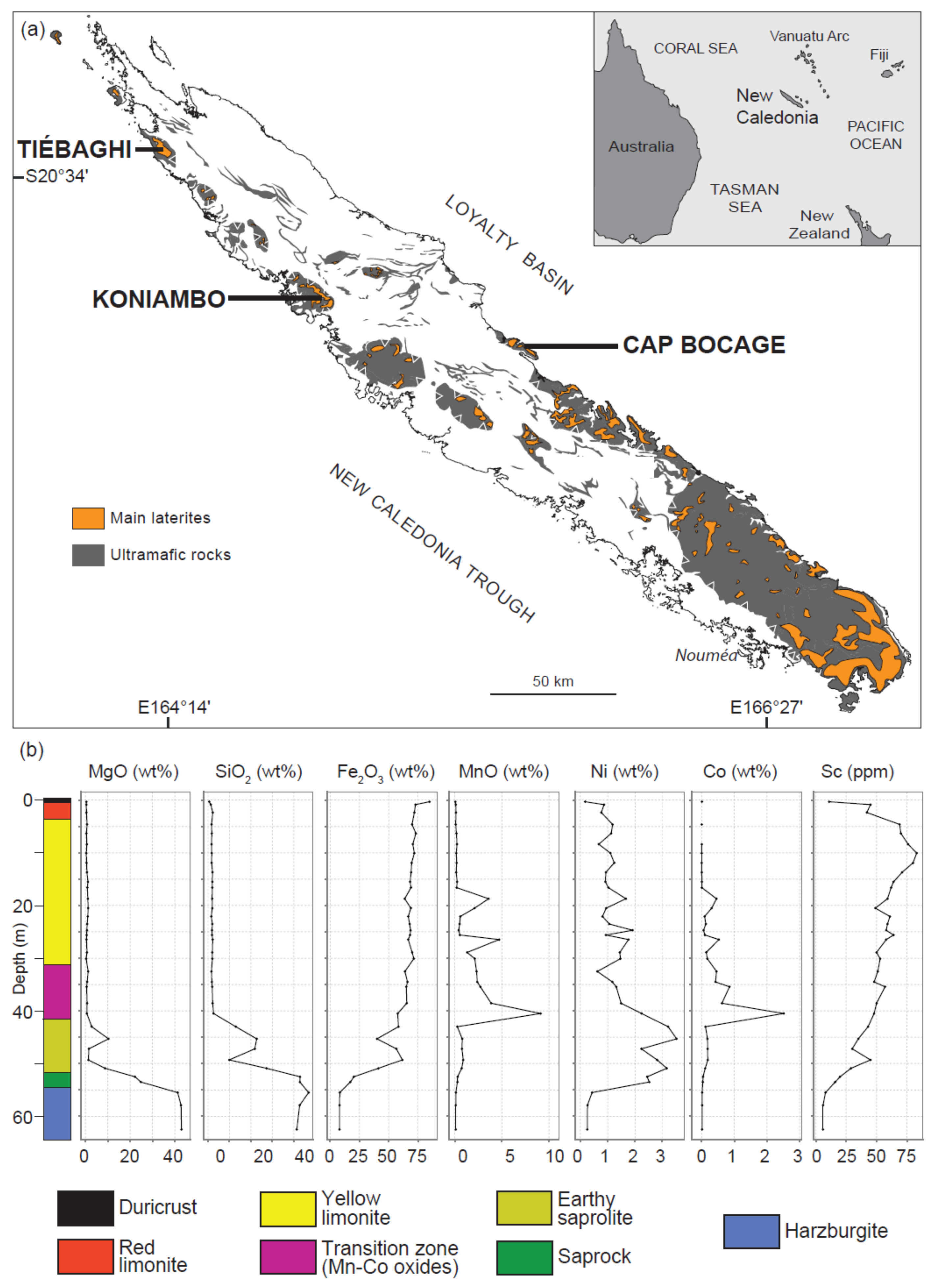


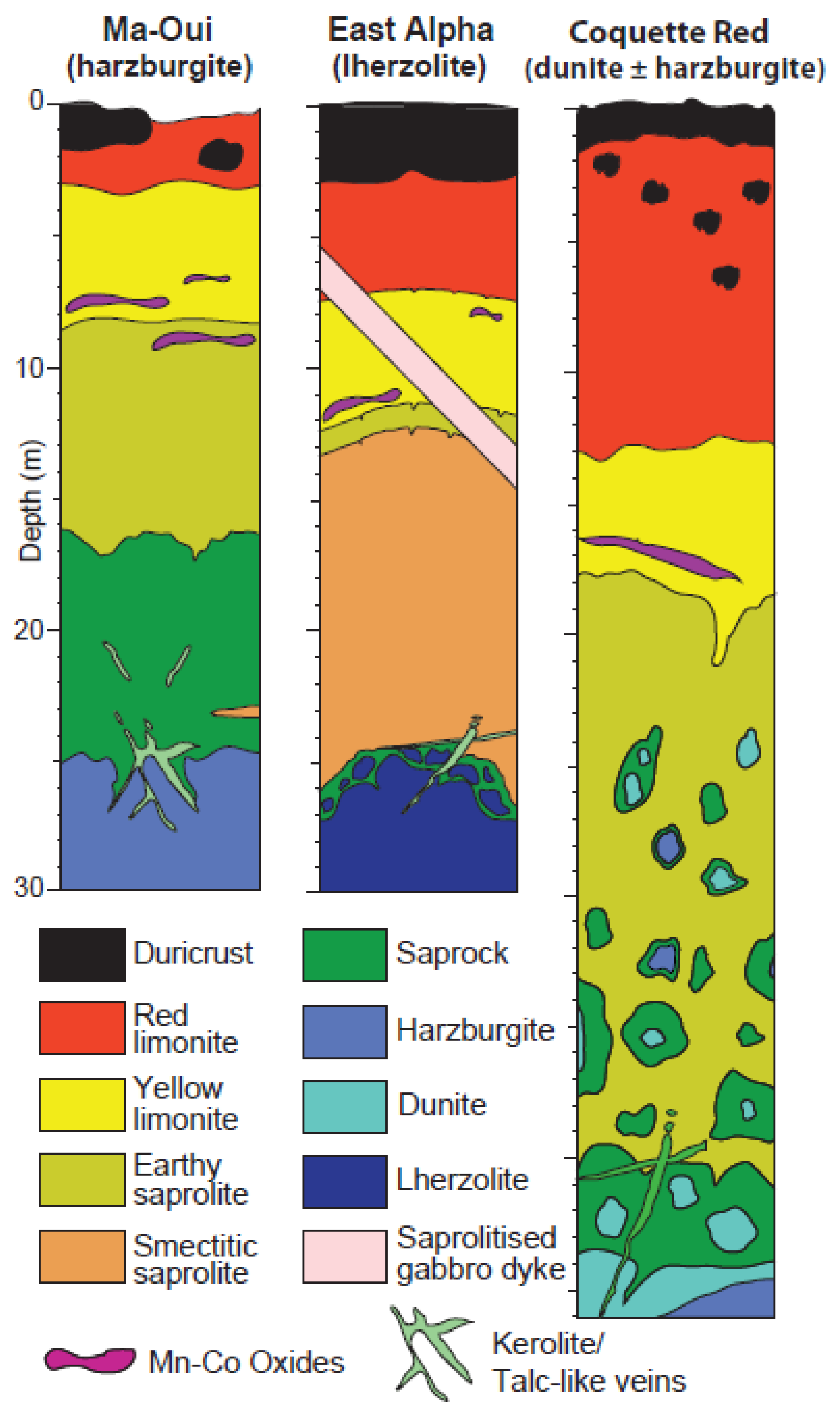
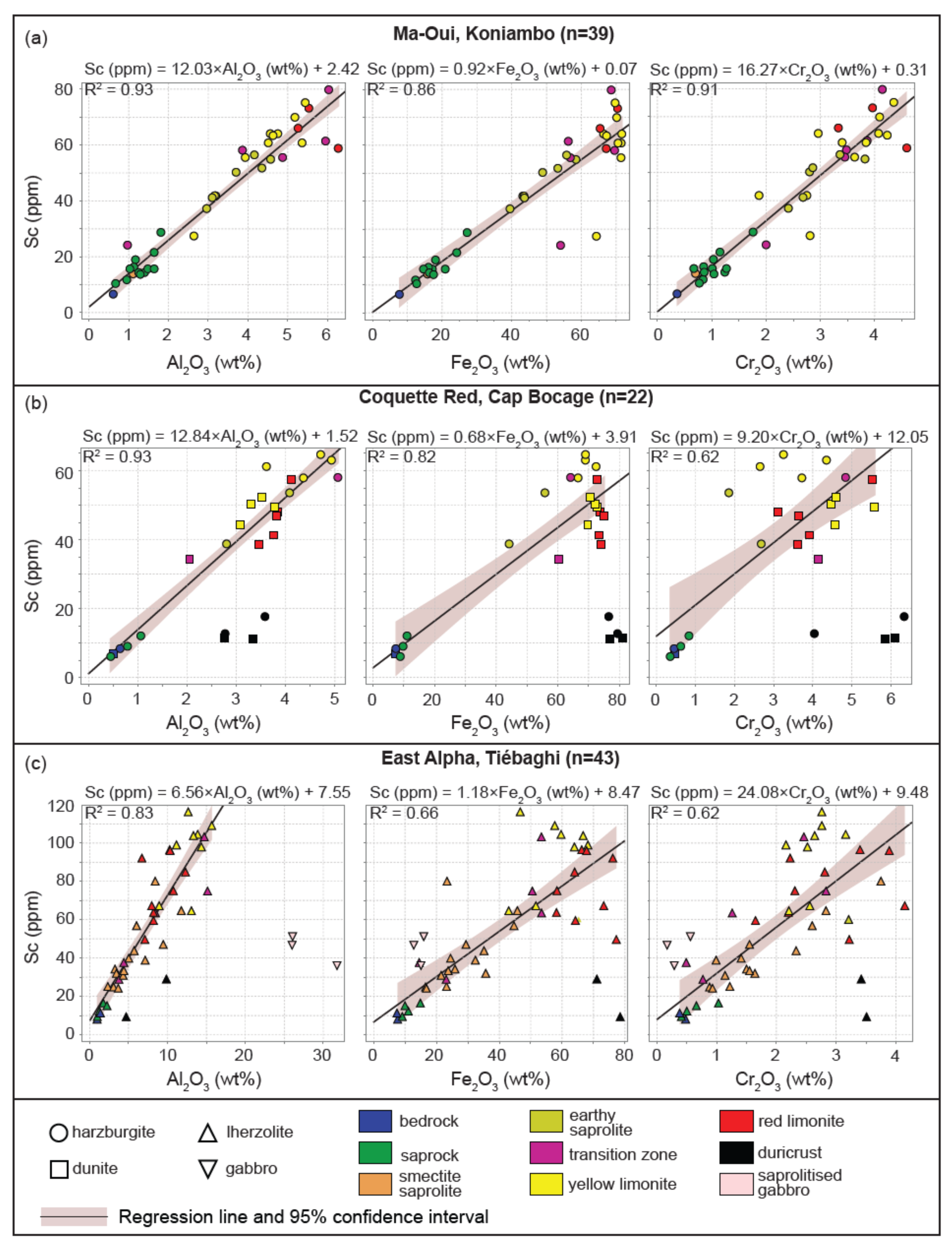


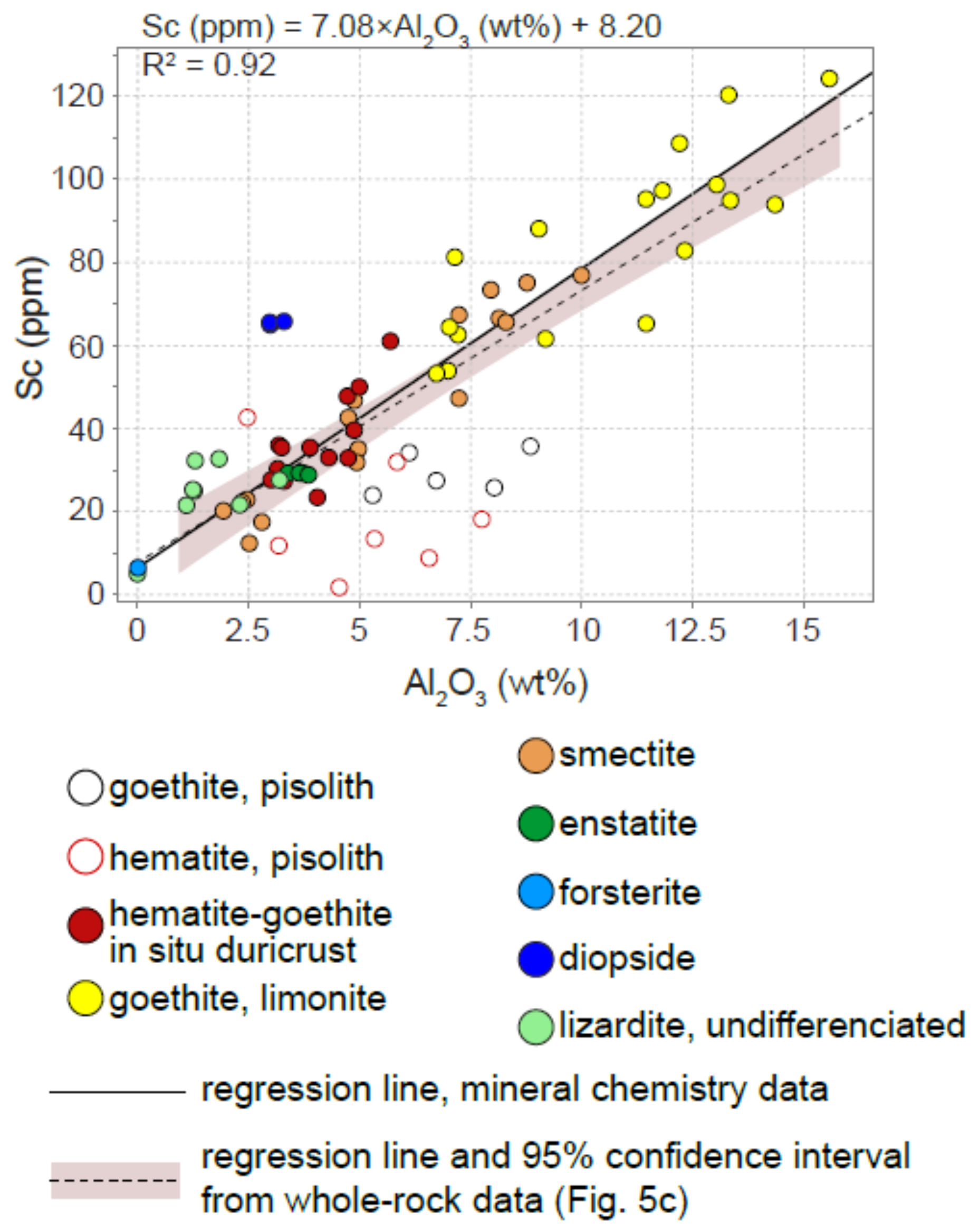
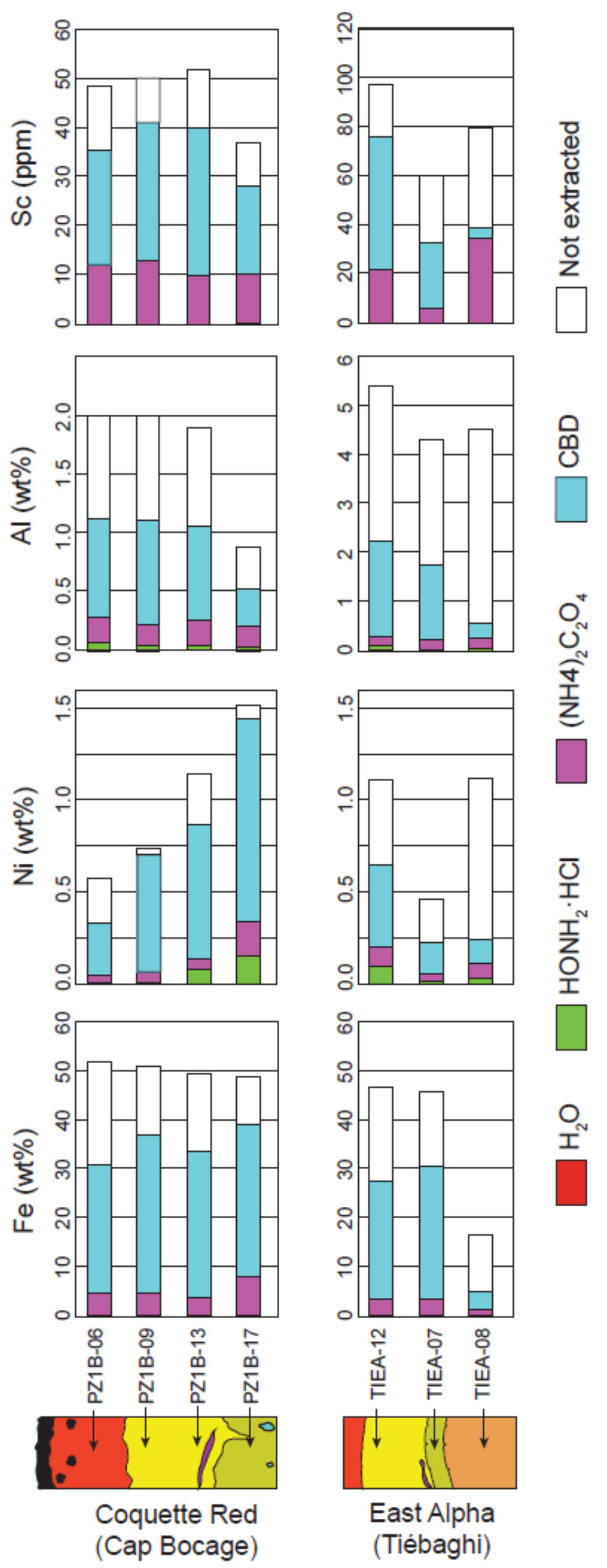
Publisher’s Note: MDPI stays neutral with regard to jurisdictional claims in published maps and institutional affiliations. |
© 2022 by the authors. Licensee MDPI, Basel, Switzerland. This article is an open access article distributed under the terms and conditions of the Creative Commons Attribution (CC BY) license (https://creativecommons.org/licenses/by/4.0/).
Share and Cite
Teitler, Y.; Favier, S.; Ambrosi, J.-P.; Sevin, B.; Golfier, F.; Cathelineau, M. Evaluation of Sc Concentrations in Ni-Co Laterites Using Al as a Geochemical Proxy. Minerals 2022, 12, 615. https://doi.org/10.3390/min12050615
Teitler Y, Favier S, Ambrosi J-P, Sevin B, Golfier F, Cathelineau M. Evaluation of Sc Concentrations in Ni-Co Laterites Using Al as a Geochemical Proxy. Minerals. 2022; 12(5):615. https://doi.org/10.3390/min12050615
Chicago/Turabian StyleTeitler, Yoram, Sylvain Favier, Jean-Paul Ambrosi, Brice Sevin, Fabrice Golfier, and Michel Cathelineau. 2022. "Evaluation of Sc Concentrations in Ni-Co Laterites Using Al as a Geochemical Proxy" Minerals 12, no. 5: 615. https://doi.org/10.3390/min12050615
APA StyleTeitler, Y., Favier, S., Ambrosi, J.-P., Sevin, B., Golfier, F., & Cathelineau, M. (2022). Evaluation of Sc Concentrations in Ni-Co Laterites Using Al as a Geochemical Proxy. Minerals, 12(5), 615. https://doi.org/10.3390/min12050615





